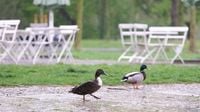The Eisheiligen, or "Ice Saints," are a well-known phenomenon in Germany that can bring frost and cold temperatures in mid-May. In 2025, these critical days are expected from May 11 to May 15, a time when many gardeners and farmers hold their breath, fearing the potential for late frosts that could damage crops and plants.
According to long-term forecasts from Wetter.com, May 2025 is projected to be generally mild and wet, which reduces the likelihood of persistent ground frost during the Eisheiligen. However, individual cold nights are still possible, especially when clear skies prevail and high pressure influences the weather. Meteorologist Jörg Riemann from the Wettermanufaktur noted that the Eisheiligen are arriving "early" in 2025, similar to last year when cold snaps occurred in April.
The Eisheiligen are a meteorological singularity, a term referring to a typical weather phenomenon that occurs annually in Central Europe. From May 11 to May 15, a cold air current may sweep down from the north, leading to a significant drop in temperatures. The names of the Eisheiligen, which include Mamertus (May 11), Pankratius (May 12), Servatius (May 13), Bonifatius (May 14), and Kalte Sophie (May 15), derive from the Bauernkalender (farmer's calendar), a traditional guide created in the 17th century by Abbot Mauritius Knauer.
The Bauernkalender is filled with weather predictions based on the observations and experiences of farmers over generations. It is said that the Eisheiligen mark a time when cold air from the polar regions collides with warmer air from southern Europe, creating conditions ripe for frost. For gardeners, the implications of the Eisheiligen are significant. Many farmers and hobby gardeners are advised to wait until after May 15 to plant frost-sensitive vegetables such as tomatoes, zucchini, cucumbers, and beans.
As the Eisheiligen approach, the concern is not just about the potential for frost but also the impact it can have on pollination. Cold temperatures can prevent bees from flying, which is crucial for the pollination of flowers and fruit trees. Thus, the stakes are high for those who rely on successful crops.
Despite the current forecasts indicating a mild spring for 2025, the risk of isolated late frosts remains. The age-old saying among farmers goes, "You can only be sure about frost after Sophie has passed!" While this saying is steeped in tradition rather than scientific validation, it reflects the cautious mindset that prevails during this period.
Historically, the Eisheiligen are linked to various farmer's rules, such as "Pankratius and Servatius are two wicked brothers, what spring has brought, they destroy again" and "Kalte Sophie makes everything here." These sayings underscore the anxiety surrounding the potential for frost during these days.
Weather records show that while frost and cold nights do occur in May, they do not always coincide precisely with the Eisheiligen. Furthermore, the Eisheiligen originate from a different timekeeping system based on the Julian calendar. Since the adoption of the Gregorian calendar in 1582, the dates of the Eisheiligen would actually fall ten days later than the traditional May 11-15 period, placing Kalte Sophie around May 26.
Looking ahead to 2025, the 42-day weather trend from wetter.de suggests that temperatures are expected to rise again in May, with predictions of exceeding 15 degrees Celsius and possibly reaching up to 26 degrees Celsius in eastern regions. However, a significant temperature drop is anticipated towards the end of May, which may not be directly linked to the Eisheiligen.
For farmers, understanding the timing of the Eisheiligen is crucial for planting schedules. The 100-year calendar indicates that from May 7 to May 16, there will likely be considerable rainfall, which could affect planting conditions. The calendar also predicts that a cold snap may occur around May 23, further complicating planting decisions.
As the Eisheiligen draw closer, gardeners are reminded to protect their frost-sensitive plants. Covering them with fleece or foil during cold nights can help safeguard them against potential damage. The consensus among agricultural experts is clear: patience is key when it comes to planting sensitive crops.
The five historical figures associated with the Eisheiligen—Mamertus, Pankratius, Servatius, Bonifatius, and Sophia—are not merely names on a calendar; they represent a blend of religious tradition and agricultural wisdom. Each saint's day carries its own set of farmer's rules, which have been passed down through generations. For instance, the saying "Mamertus has a cold heart" warns of chilly conditions on May 11, while "If it freezes on Pankratius, much will be ruined in the garden" emphasizes the risk associated with cold snaps during this time.
In Northern Germany, farmers primarily focus on Mamertus, Pankratius, and Servatius, while in the South, Bonifatius and Kalte Sophie are also considered significant. This regional variation in the observance of the Eisheiligen reflects the differing climatic conditions across Germany.
As 2025 approaches, the anticipation surrounding the Eisheiligen continues to grow. Will they bring the dreaded frost that gardeners fear, or will the mild forecasts hold true? Only time will tell, but for now, all eyes are on the sky as the Eisheiligen prepare to make their annual appearance.






